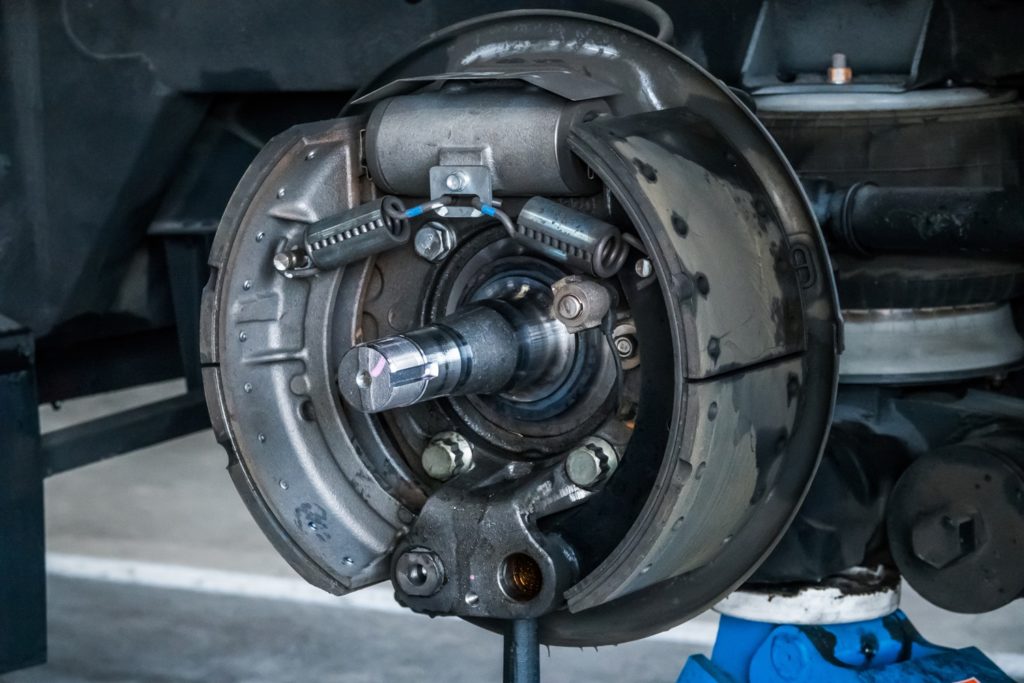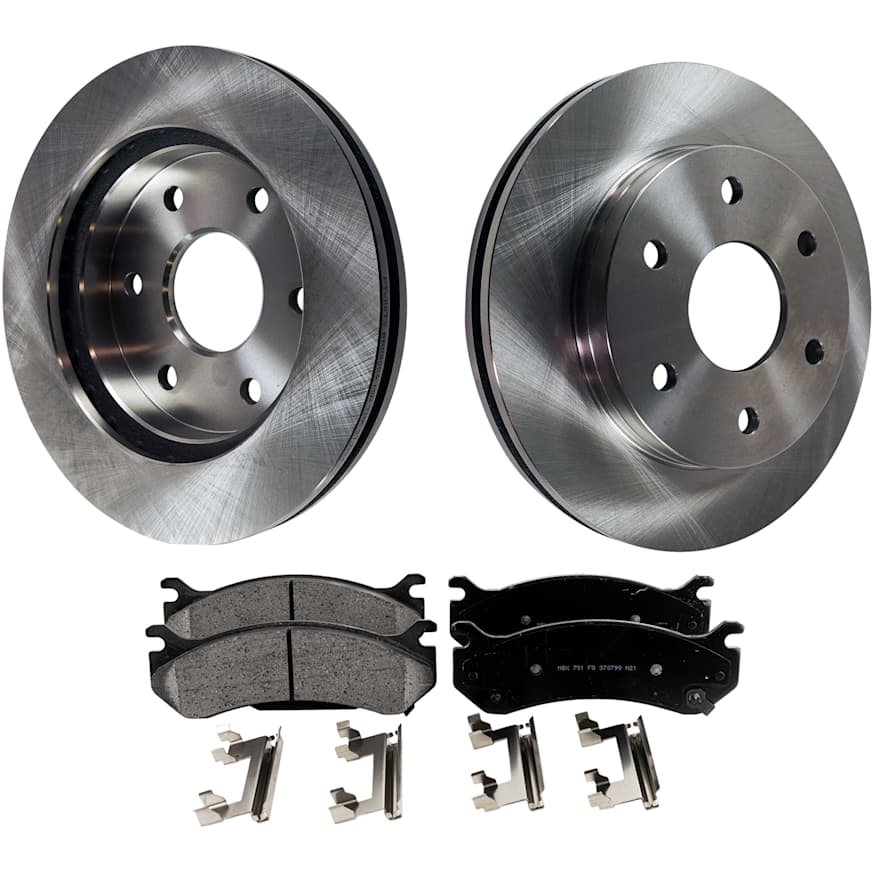Brakes serve to slow down your car and bring it to a stop. But have you ever wondered how your car’s brake system can bring your vehicle from a hundred miles per hour down to a snail’s pace within a few seconds?
How Brakes Work
Each wheel on your vehicle comes with its own brake and attached hydraulic device. All four brakes respond to the brake pedal.
Stepping on the pedal activates its lever and its connected piston. Powered by your foot, the lever forces a piston inside the master cylinder. The piston then displaces brake fluid out of the cylinder and into the lines that lead to either the brake calipers (in a disc brake system) or the wheel cylinders (in a drum brake system) hooked up to the brakes.
Under pressure and expelled from the master cylinder, the brake fluid amplifies the force transmitted by your foot. Using this force, each brake caliper squeezes a pair of brake pads against a rotor, creating friction.

In a drum brake system, a wheel cylinder at each wheel forces a pair of shoes outward against a drum to create friction.
Be it disc brakes or the older drum brakes, brakes work by creating friction to slow the wheels. By making it much harder for the wheels to keep turning, the brakes drastically drop the vehicle’s speed.
Check out this video to know more about how car brakes work:
The Science Behind Car Brakes
A stationary object possesses potential energy, which is the energy stored within an object thanks to gravity and other factors around it. Applying enough force on a non-moving object converts its potential energy into kinetic energy and allows it to move.
In vehicles, the engine provides the power required to turn potential energy into kinetic energy. The stronger the engine’s output, the more kinetic energy it imparts to your car, leading to better acceleration and higher speeds.
Once it gets underway, a moving object will continue to move until all its kinetic energy returns to potential energy. Higher speeds impart more energy, so the momentum from going fast carries the object further along for longer periods even after it loses its source of propulsive energy.

Brakes reduce kinetic energy by ramping up friction, which is the resistance to motion of one object moving relative to another. Apply enough friction and you can stop a fast-moving car within a scant distance and a brief period.
By ramping up the friction between them and the wheels, brakes quickly convert kinetic energy into heat. Deprived of the energy it needs to keep running, the car comes to a stop much faster than if allowed to coast until its momentum peters out.
Types of Car Brakes
There are four common types of brakes systems installed on vehicles–disc brakes, drum brakes, emergency brakes, and anti-lock brakes.
Disc Brakes
This brake type got its name from its appearance—they resemble discs. Some people also refer to the discs as “rotors.”
A disc brake pad and rotor assembly contain the following parts:
- The eponymous brake disc that rotates along with the wheel
- A brake pad made from a high-friction material
- A brake caliper that presses the pad into the disc to stop the wheel from moving

How Disc Brakes Work
Calipers get their power from the pressurized brake fluid that flows from the master cylinder. When you step on the brake pedal, hydraulic fluid from the master cylinder rushes into each of the calipers.
The force delivered by the brake fluid lets the calipers pin the brake pads against the brake disc.
Once they come into physical contact with the brake disc, the brake pads’ surface generates friction. They slow down the rotational speed of the discs and the wheels by converting kinetic energy into heat that radiates from the pad.
Deprived of the kinetic energy they need to keep turning, the wheels will slow down until they stop altogether.
Most modern vehicles use disc brakes to stop safely. Some have disc brakes at all four corners, while others have discs in the front and drums in the rear.
Drum Brakes
Drum brakes preceded disc brakes. On some vehicles, they continue to serve alongside the newer brake type.
The drum brake assembly comprises the following parts:
- Brake drum
- Brake shoes with friction linings

How Drum Brakes Work
The brake drum connects with the wheel and rotates along with it. The hollow drum fits over the brake shoes with room to spare.
Stepping on the brake pedal triggers the wheel cylinders to press the brake shoes against the inside surface of the brake drums. The shoes’ lining generates friction that robs the drums of kinetic energy.
Since the brake drums turn alongside the wheels, slowing or stopping them serves to decelerate the wheels.
Many classic vehicles rely entirely on drum brakes. Some modern vehicles still use drum brakes on their rear wheels to save on production costs.
The Difference Between Disc Brakes & Drum Brakes
While functionally the same, disc brakes and drum brakes offer different benefits.
Cost
Many car manufacturers save on production costs by fitting the rear wheels with cheaper yet still-effective drum brakes.
Heat Dissipation and Brake Fade
Engaged brakes produce lots of heat and need to get rid of it fast. If they can’t manage their temperature, their performance can become inconsistent, leading to brake fade.
Disc brakes handle heat better than drum brakes. They remain cooler after repeated uses, making their performance more consistent.

Performance in Wet Conditions
Brakes depend on friction to stop the car’s wheels, and they don’t mix well with moisture. They become slippery when wet, which reduces their ability to create friction to stop your car.
The hollow shape of drum brakes makes it easier for moisture to gather and pool inside the drum. In contrast, disc brakes not only shed water easily, but they also get wiped dry by the brake pads, which helps keep them drier and lets them maintain their effectiveness.
Locking Up
Disc brakes enjoy the advantage of having a simpler and more straightforward design.
This means they lock up less often than drum brakes.
Materials
Brakes can get hotter than 510 degrees Celsius (950 degrees Fahrenheit). That’s equivalent to five times the boiling point of water.
Brake pads and brake shoes must withstand these temperatures whenever you step on the pedal. Heat-resistant substances like alloys, ceramics, and composite materials see much use in the manufacture of car brake parts.
Parking Brakes (formerly known as Emergency Brakes)

Since 1967, federal regulations have required the use of dual or tandem master cylinders as a safety measure in case one-half of the braking system fails. Today, all vehicles must adhere to the Federal Motor Vehicle Safety Standard (FMVSS) 135 which requires them to have a parking brake that can hold a fully loaded vehicle stationary on a slope of 20% up or down.
How Do Parking Brakes Work
Parking brakes are applied by depressing a pedal, pulling a floor-mounted lever, or activating a handle from inside a vehicle. When applied, a warning lamp on the dashboard activates to prevent damage to the brake drums or rear discs and pads in case the driver attempts to accelerate while the parking brake is engaged.
Antilock Brake System
Friction between the tire tread and the road surface is what slows down a vehicle and allows it to stop moving. All four wheels need to maintain contact with the road surface, especially while driving in wet, icy, or snowy conditions. The antilock braking system (ABS) prevents wheels from locking and losing traction while braking, especially on low-friction surfaces.

Some ABS units will cause the brake pedal to pulse as antilock braking is activated. However, there are systems with an isolator valve that prevents brake pedal pulsations. This may make it hard for the driver to determine when the vehicle is in ABS mode.
How Does the ABS Work
Speed sensors monitor the rate of deceleration of each wheel to detect possible wheel lockup. If the the ABS control module detects that one wheel is rotating slower than the others, it will direct the ABS hydraulic controller to reduce brake fluid pressure to that wheel for a fraction of a second before it reapplies pressure.
Pulsing the brakes on and off allows the vehicle to maintain directional stability and maximum braking force during a sudden stop or while driving on slick surfaces.
Have Faulty Brakes? Get Replacement Parts Online
Brake failure is a serious problem. Brake components typically show an array of issues before they fail. However, ignoring these signs will increase the likelihood of brake failure. For your safety, you should replace your vehicle’s faulty brake components immediately. Good thing CarParts.com is a trusted source for all sorts of brake components including brake disc and pad kits, brake calipers, and brake caliper pistons, among other brake parts.
Here at CarParts.com, our brake components are made with modern manufacturing techniques and the precise specifications of the original part. This ensures that the replacement will fit and function like the original.
Don’t ignore your vehicle’s faulty brake components. Check out our selection of brake discs and pad kits, brake calipers, and brake caliper pistons here at CarParts.com today!
Any information provided on this Website is for informational purposes only and is not intended to replace consultation with a professional mechanic. The accuracy and timeliness of the information may change from the time of publication.































